When it comes to buildings, energy management is often imbedded (yet not defined specifically) in many facets of a building and how it functions. Energy and risk management can also be areas of losses for customers and insurers alike.
Building operation and maintenance
Just like people, buildings age – and so do the systems that are required to function at an optimal level. Every building, including their systems, requires routine maintenance and upgrades to not only operate as they should, but also limit potential losses. Leaks, cracks in the exterior, missed scheduled maintenance, poor function lighting or aged technology that no longer functions all lead to inefficiencies in energy usage.
Security and energy risks
Security covers a wide variety of energy-related systems, including lighting (inside and outside), access control systems, electronic data processing or computer systems, CCTV, burglar alarms and remote monitoring building systems.
Equipment and resources
Aged, poorly maintained, outdated or equipment lacking monitoring/control can have poor energy performance and high consumption patterns. Heating, ventilation and air conditioning systems, motors, domestic water systems, and lighting are all major electrical systems that most buildings have and lead to energy consumption inefficiencies.
Quality of environment for occupants
People like to work in environments that are comfortable and allow for ease of work. Air quality issues, drafts, and poor lighting all can cause a building to be considered “unhealthy” and can have potential property or liability claims.
What does an economic energy audit look like?
Are you ready to consider an energy management plan? An energy audit can assist with identifying specific aspects of your business operation that may be operating inefficiently. However, this must be completed by a trained professional.
Preliminary (Level 1)
This is a simple audit that involves a basic walk-through assessment, review of utility bills and other applicable operating data and interviews with operations staff. This basic evaluation is designed to identify glaring energy problems. With the detail of this audit, low-cost upgrades are proposed, energy efficiency projects can be prioritized and it is determined if a more detailed audit is necessary.
Detailed (Levels 2 and 3)
Level 2 audits are more detailed energy calculations with added financial analysis of proposed energy measures. This level of audit uses utility data over a longer period. The financial analysis is used to build a business case for implementing energy measures.
Level 3 audits provide a more in-depth analysis of energy use in the building. This can include sub-metering of major energy systems. The added level of detail in the analysis of the existing building and proposed energy measures means that cost and savings have an increased level of accuracy. This level of detail can provide higher quality, more accurate data, which is valuable major energy projects that can be capital intensive.
Who conducts energy audits?
It’s important to identify your building’s energy-related risks to ensure you’re as protected as possible. Conducting an energy audit is dependent on the specifics to your building and should be completed by those qualified to do so, such as those completed by Energy Star.
Learn more about energy and risk management
For more information about energy and risk management, talk to your insurance broker or Aviva’s Risk Management Solutions team at arms.canada@aviva.com.
Helpful resources to learn more:
ENERGY STAR Certification for Buildings | ENERGY STAR
Energy Efficiency – Government of Canada













